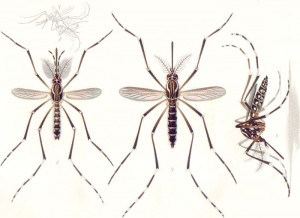
Viva la difference — and the difference is in the antennae. Mosquito antennae are lined with fine hairs called antennal flagellum, and the density of the flagellum differs from one sex to another. Males have many, many more antennal flagellum, turning their antennae into a pair of bushy bottle brushes. Megan Fritz, a post-doctoral student in the North Carolina State University department of entomology described them to me as the mosquitoes' mustache. Even though mosquitoes are tiny, the males' flagellum are prominently noticeable to the naked eye. Fritz can tell which mosquitoes are boys and which are girls, on sight.
Female Aedes aegypti do the biting. But they don't have nearly as many flagellum and, thus, their hearing is not nearly as finely tuned as that of male mosquitoes. That's because the men and the women are looking for different things.
Female mosquitoes are on the lookout for victims to bite. Like the males, they eat sugar. At the NCSU mosquito breeding facility, Megan Fritz feeds both males and females on sugar water. But, without regular meals of blood, the females lose their ability to reproduce. No blood, no baby mosquitoes. Unsurprisingly, then, female mosquitoes have special sensory abilities that allow them to find and procure blood.
Males, on the hand, are primarily interested in finding females. And that's where those thick flagellum come in. Turns out, the flagellum are integral to the mosquitoes' ability to hear. Specifically, all those flagellum help male mosquitoes hear the very, very, very quiet sounds of female mosquitoes buzzing around. Sound waves make the flagellum move. That movement is carried through the antenna to a special organ that helps the mosquitoes actually make sense of the motion. Called Johnston's organ, it can tell males how fast the wings of nearby mosquitoes are beating and it can help them distinguish male from female, and species from species.
You can read more:
• The Mosquito Reference Manual
• A research paper that explains how mosquitoes hear and how the antennal flagellum work
• Another paper that describes several ways that male mosquitoes use their antennae to explore their world

No comments:
Post a Comment